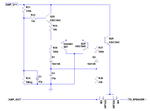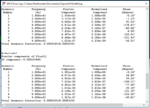northumber82
Member level 3
Hi guys, I designed this amplifier output protection for speakers. This circuit blocks DC output from amplifier and is also an antibump.

Originally, the circuit was using a relay, I replaced it with a mosfet relay. There is a problem in that? In simulation I see no problems, but some guys says that there are additional distortion using mosfets at the output.

Originally, the circuit was using a relay, I replaced it with a mosfet relay. There is a problem in that? In simulation I see no problems, but some guys says that there are additional distortion using mosfets at the output.

